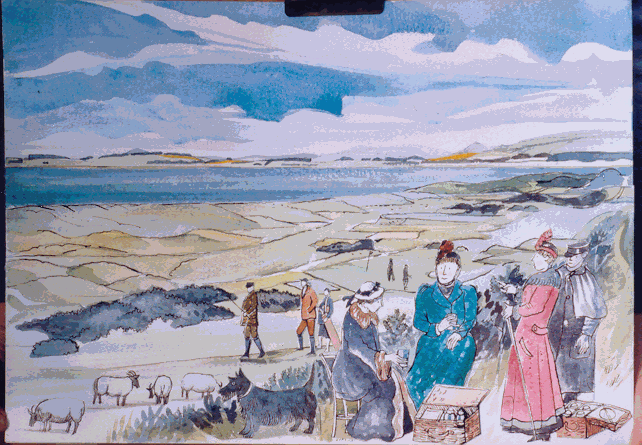
19th Century
The 19th century sees an even greater amount of documentary evidence of life in the town becoming available as central government delegated the management of health, education, sanitation, etc. to local authorities. This documentation provides us with a detailed insight into the social conditions existing within the parish – particularly during the latter half of the century. The century begins with the infamous Sutherland Clearances, and ends with the first small steps being taken to promote tourism in the area.
The Clearances
The parish of Dornoch suffered less extensively from the clearances carried out on behalf of Elizabeth, Countess of Sutherland and her husband, the Marquis of Stafford (later 1st Duke of Sutherland whose statue stands atop Beinn a Bhragaidh). The nearby estate of Skelbo was cleared, and families that had been removed from other parts of the county found refuge in Dornoch itself, particularly in the area now known as Littletown.
Embo was one of several coastal settlements which took in cleared families during the Clearances. In an attempt to encourage the now landless crofters to take-up fishing, the Marquis of Stafford built harbours along the eastern coast of the county. Embo's harbour is now unused but you can still see the village's herring heritage in the layout of its older streets.
The 1809 Meikle Ferry disaster
For centuries the Meikle Ferry, which followed a line roughly 200 metres inland from the current-day Dornoch Firth Bridge, was the only route south without a long overland journey. In 1809 this busy ferry route became the scene of a tragic disaster. It was a disaster on an unprecedented scale for south-east Sutherland: few families in the area were unaffected by the catastrophe which highlighted the dangers of travel at the time.
On 16 August 1809 more than one hundred people boarded the ferry at the Dornoch end. Some were carrying goods and stock to sell at the Tain Fair, others had money with them to pay into the Bank of Tain. The conditions were calm but the boat was dangerously low in the water. As the overcrowded boat turned broadside to the tide, it became swamped and sank almost immediately.
More than half of the ninety-nine people who drowned that day were from Dornoch parish. Dozens of families, like the ferryman's own widow and nine children, were left destitute and without income. News of their suffering travelled a surprising distance. Within two years a disaster relief fund had raised an incredible £2,900, more than half of which came from soldiers and emigrants far away in India and South Africa.
Life within the parish
The 19th century was a period of great change for Dornoch. By 1815 many improvements had been made to the town: the route of the old burn had been diverted; feal-houses (turf roofed) were cleared from the vicinity of Castle Close; the old Tolbooth and Council House had been demolished; and the Jail and Council Chamber relocated to the refurbished Bishop’s Palace.
Between 1835 and 1837 major, and somewhat controversial, repairs were made to the Cathedral by the Countess of Sutherland. Nevertheless, there were still regular escapes from the county jail, cholera briefly threatened the community and there was an outbreak of smallpox in the town. Poverty and poor housing were widespread and well-intentioned attempts were made by the parochial Board to alleviate the suffering – to little avail.
However the latter half of the century saw the local council assume a greater responsibility for social and economic conditions within Dornoch, and by the beginning of the 20th century health, housing and sanitation had improved considerably.
The development of tourism
In 1877 Dornoch Town Council granted permission for the Sutherland Golfing Society to play golf on the town links. This was the start of a long – and mutually beneficial – association between the town and the game of golf: today golf is the most important component of the town’s thriving tourist industry.
 Council records also show that local inhabitants became aware of the town’s potential as a tourist resort.
Council records also show that local inhabitants became aware of the town’s potential as a tourist resort.
Many locals began erecting new houses for the summer visitors, while a number of non-residents built holiday homes for themselves.
Attempts were made (unsuccessfully at first) to connect Dornoch with the main Highland Railway branch-line in order to make the town more accessible to visitors, and a new hotel was built in the town’s main square. The presence of Andrew Carnegie at nearby Skibo Castle (from 1898) enhanced Dornoch’s reputation as a desirable holiday destination for the wealthier classes.

